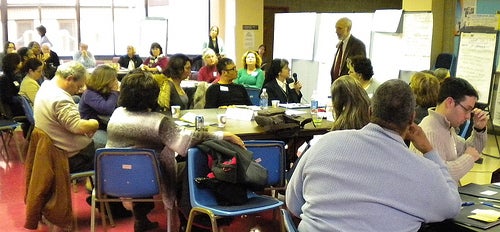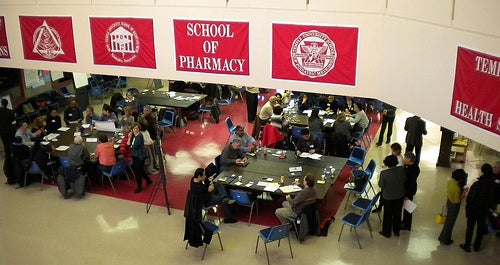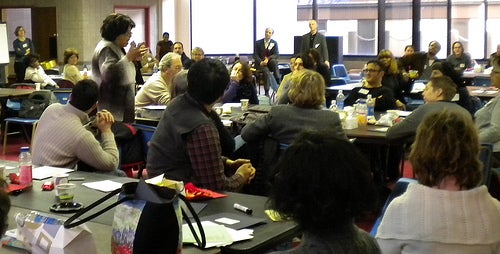Civic groups show neighborhood colors at zoning event
January 24, 2010
By Thomas J. Walsh
For PlanPhilly
“Since zoning principles are already established in Philadelphia, the problem before the new zoning commission is to extend their use to meet the citywide needs which now exist,” according to a report from the Economy League of Greater Philadelphia. “In this work the experience of the past will serve as a useful guide.”
It’s solid advice these days, just as it was in April 1924, when it was published by what was then known as the Bureau of Municipal Research of Philadelphia. In 1954, the bureau merged with the Pennsylvania Economy League to create the entity we know today.
The Economy League celebrated its 100th anniversary in December, and a careful culling of its massive volumes by our friend Alison Kelsey, the League’s communications director, show clearly that frustrations about the city’s zoning code are not new.
“A thorough overhauling of Philadelphia’s outmoded zoning is getting underway,” one report stated, in November of 1955. At the time, the new commission was “holding public hearings at which interested groups and citizens may express their views on zoning problems and on the manner in which the commission should approach the revision of the Zoning Ordinance and Map.”
The past was prologue Saturday, when more than 100 members of civic associations, neighborhood associations and community development corporations met inside the Student-Faculty Center at Temple University’s School of Medicine. It was the second meeting of three arranged by the Penn Project for Civic Engagement (PPCE) at the University of Pennsylvania and the local chapter of the American Institute of Architects. Last Tuesday (Jan. 19, 2010), the first meeting – with developers, land use attorneys, economic development officials, architects and other professionals – was held at the Union League.
The third and final meeting, scheduled for Wednesday evening (Jan. 27), will combine representatives from both meetings, creating the rare scenario of developers in direct dialogue with civic groups and a third-party moderator.
Zoning is cool
Like computer geeks over the past decade or more, it appears that zoning wonks are proclaiming that although their task may be nerdy, it is essential.
“Today we can relax and talk about the fascinations of zoning and not be accused of being the most boring people in the world,” said Kiki Bolender, a Philadelphia architect and AIA member, at the start of Saturday’s jam-packed gathering. She and Penn professor Harris Sokoloff, director of the PPCE, conducted the six-hour workshop. Members and staffers of the Zoning Code Commission and Philadelphia City Planning Commission were invited to attend as observers, and at least a half dozen were on hand Saturday, including ZCC Executive Director Eva Gladstein.
“I’m learning about zoning cases and reviewing negotiations and experiences from a variety of community groups,” said Richard Redding, director of community planning for the City Planning Commission. “Some of these are new stories and new lessons and are very informative. I’m also being approached by one or two communities that have some pretty serious requests of the Planning Commission. It’s good for me to be here and be available to the community leaders.”
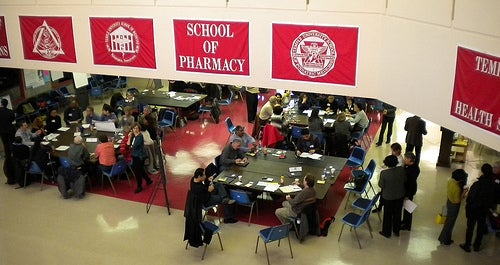
The ZCC is nearing the completion of its first major “module” for a fully re-written zoning code, the first in more than 50 years and on track for submission to City Council by early fall. The meetings with developers and community groups (entitled, “Common Ground for Building Our City”) are meant to augment other public outreach events held by the ZCC itself over the past year and continuing through this spring.
“It’s not unusual for leaders in a city to ask the public for input,” said Sokoloff. “What’s usual … is that it feels like it goes into a deep black hole someplace, and nothing happens to it. That is not the case with the work we’re doing today. The officials of the Zoning Code Commission have promised not only to listen, but to respond.
“They will also say, ‘This is what we heard you say, and this is what we did with it.’ So there will be sort of a feedback loop to you that you’re not used to getting from your elected officials.”
Ground rules for reporters at the meetings are that all attendees’ comments during the workshops and break-out sessions, and their presence, were off-the-record, in order to bring about a free flow of ideas and opinions and “explore disagreements,” in Sokoloff’s words.
The representatives from civic associations from around the city were broken up into eight working groups over three sessions, meant to identify how the development review process can support neighborhoods’ best interests. Also addressed was how that review process might interfere with the neighborhoods’ best interests, and how to develop common ground principles.
The second part of the day was spent “telling stories” about the process, along with things that help it along and those that hinder it – when the public review process actually worked for a project in a given neighborhood (including instances where it stopped a project) and when it did not work.
One representative from a neighborhood association said that if push comes to shove with stopping an unwanted development that is seeking a variance from the Zoning Board of Adjustment, it is important to keep the obvious in mind: that a “variance” means an exception to current law. The importance of being persistent cannot be overstated, it was said.
The implication was that the ZBA should act in such circumstances like an NFL referee, who must review a questionable play if requested to do so, via a red flag tossed onto the field by one of the coaches. In this scenario, the initial ruling is the law, and the red flag is the variance request. The football ref must see undisputed evidence that would clearly call for overturning the initial ruling. If there is any gray area in the replay, the initial ruling stands.
Just like the NFL, though, sometimes this kind of thing holds up at the ZBA, and sometimes it doesn’t. When the ZBA simply rules on a variance or a controversial development decision with no discussion or debate, some of those assembled said, it smacks of political influence. The term “pay to play” was used, along with projects that only come to light after they are already “a done deal.” One participant said the ZBA’s system needs to be revamped so that it doesn’t take an advanced degree in planning to understand, or a lawyer to trigger an action challenging it.
Laws concerning zoning also must have teeth, another group said. Currently, they contend, the age-old adage, “Better to apologize than to ask permission,” is a little too commonplace. Developers might gladly pay a fine and avoid a public engagement process that could delay construction.
The attendees were also self-critical. Conflicts between civic groups is not uncommon – even in the same neighborhood, where upstart factions “with a special interest” supersede older, more established associations. Also, community groups are occasionally not above acting from a sense of “middle or upper-middle class privilege,” and that sometimes, the negative effects of gentrification on a neighborhood are brought about by new, vocal, organized residents as much (if not more) than the developers themselves.
Still others were quite pessimistic about the hope of affecting actual change, and doubted that the ZCC would incorporate their suggestions.
“The tone of our group meeting here – there are nine of us from totally different parts of the city – is that there is unanimous distrust, based on years of experience on zoning matters with City Council, with the ZBA and with the Planning Commission,” said Tom Sauerman, a participant from the East Falls Community Council. “Even being involved in this process today, there’s a feeling that it will be of little or no value. The train is running already at 90 miles an hour, and it’s not about to stop, or change because of our concerns.”
Gladstein responded by saying there have been 14 neighborhood-based meetings to date, with another 12 scheduled for the coming months. There have also been 27 monthly meetings of the Zoning Code Commission which, though held on weekday mornings, are nonetheless open to the public (along with being videotaped and posted the same day by PlanPhilly). There have been two public hearings on zoning at City Council meetings since the current ZCC was formed, Gladstein added. More than 1,500 people took the ZCC’s first online survey, with a second recently posted (there will be four surveys in all).
“I’ve been involved,” Sauerman said of the neighborhood meetings. “Two and a half hours on one night? Six hours in one day today? Yes, we’ve been involved, but it’s like we’re being placated. … The future is that the developers are going to get carte blanche.”
“The new trend, the underlying tension here, is about a zoning code that could possibly result in fewer zoning variances, and the community groups’ fear of loss of control,” Redding said. “That’s a theme that’s on everybody’s mind in this room.”
Others participants, not wishing to speak on behalf of their entire civic association, were much more positive, saying they understand mistrust, but that workshops of the type held Saturday and last week for the developers are themselves a big sign of changing times.
Many of the concerns of the community groups were similar to those of the developers and builders: Consistent project and design review measures, transparency and full disclosure, working relationships, early notice and address of problems, equitable decisions, proper means of valuing property, consolidation of city agency procedures, a willingness to compromise, identification of who truly speaks for the neighborhood, and more.
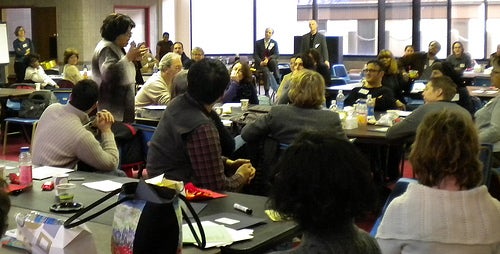
What’s next
Module Two of the new zoning code, due in April, is “districts and uses.” Module Three, “development standards,” will be finished in July. The actual re-mapping – when the new zoning categories are applied to specific pieces of land – will happen during 2011.
The new code will either be accepted by City Council in full, as re-written, or rejected, Bolender told the crowd. The Council members themselves will not tinker with it.
“So we wanted to make sure that we had a code that people would be buying into from all sides and from all parties,” Bolender said. “The neighborhoods, the developers – a code that really worked for the city of Philadelphia.”
To that end, outside consultants have had some recommendations for the ZBA. They include suggestions to:
• “Formalize and promulgate the conditions prerequisite to the granting of variances and exceptions”
• “Develop an expanded program which will assure the Board’s being advised of the interest of other public agencies in certain zoning cases”
• “Review formally” and regularly … “the zoning review process so that the impact of zoning decisions … can be seen in perspective against the backdrop of changing neighborhood conditions and community objectives”
• “Allow the Board to delegate to a qualified staff employee the power and duty to hold public hearings on specified types of cases.”
All of these suggestions have been talked about by the Zoning Code Commission and its hired consultants in the last 18 months, and will likely be adopted in some form or another within the new code.
If so, the suggestions can be filed under “better late than never,” since they were written and published in 1958 – delivered to that era’s “Zoning Advisory Commission” by the Economy League.
Contact the reporter at thomaswalsh1@gmail.com.
Coverage:
• A report on the developers’ workshop from Jan. 20 can be read here.
• Look for a story Thursday on Wednesday evening’s combined finale on PlanPhilly.
• Results of all three “Common Ground” workshops will be posted on the ZCC’s Web site, Sokoloff said. WHYY-FM radio is also due to have reports on Saturday’s meeting aired Monday morning, and testimonials about the sessions will be posted to the station’s Web site.
WHYY is your source for fact-based, in-depth journalism and information. As a nonprofit organization, we rely on financial support from readers like you. Please give today.



